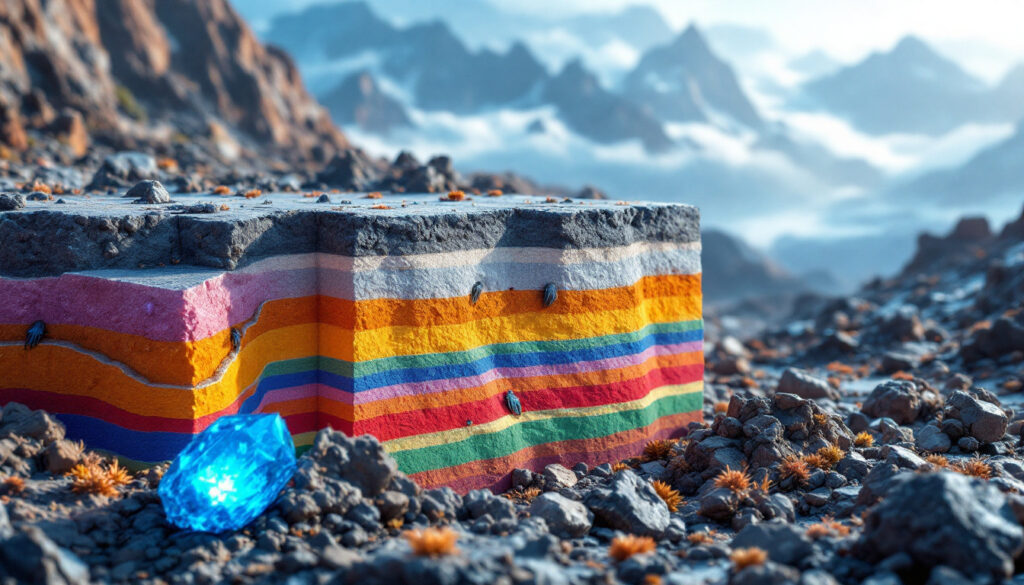What is Rock Dating in Geology?
Understanding Time Without Birth Certificates
Rocks preserve Earth's history, but unlike human records, their ages must be deciphered through systematic analysis. Geologists use two primary approaches: relative dating, which sequences events without exact ages, and absolute dating, which assigns numerical ages using radioactive decay. These methods emerged from centuries of geological observation and 20th-century advancements in nuclear physics.
The Two Main Dating Methods
Relative dating relies on stratigraphic principles and fossil succession to order rock layers. For example, the law of superposition—the concept that deeper layers are older—was formalized by Nicholas Steno in 1669. Absolute dating, developed after the discovery of radioactivity in the late 19th century, quantifies ages by measuring isotope ratios. Ernest Rutherford's 1905 proposal to use radioactive decay as a geological clock revolutionized the field.
How Does Relative Dating Work?
The Principle of Superposition
In undisturbed sedimentary sequences, younger layers accumulate atop older ones. This principle, demonstrated experimentally by depositing sand in water tanks, allows geologists to reconstruct timelines even in complex terrains. For instance, the Grand Canyon's layered strata reveal over a billion years of Earth's history through superposition.
The Law of Original Horizontality
Sediments initially settle horizontally in calm environments like lakebeds. Tilted or folded layers indicate post-depositional tectonic activity. James Hutton's 18th-century studies of angular unconformities in Scotland exemplified how this principle reveals geological upheavals.
Using Index Fossils as Time Markers
Index fossils, such as the trilobite Redlichia takooensis, provide precise temporal markers. This species, found in South Australia and South China, only existed between 514–509 million years ago, enabling global correlation of rock layers. William Smith's 1815 geological map of England pioneered the use of fossils for relative dating.
What Makes Absolute Dating Different?
The Discovery of Radioactivity
Henri Becquerel's 1896 discovery of radioactivity and Marie Curie's subsequent work on decay rates laid the foundation for radiometric dating. By the 1950s, Clair Patterson used uranium-lead dating to calculate Earth's age as 4.54 billion years, a figure still accepted today.
How Radioactive Decay Works in Rocks
When minerals crystallize from magma, they trap radioactive isotopes like uranium-238. Over time, these isotopes decay into stable daughter products (e.g., lead-206) at predictable rates. A zircon crystal, for instance, rejects lead during formation but retains uranium, making it an ideal "time capsule" for dating.
Understanding Half-Life in Dating
Half-life—the time for half of a radioactive isotope to decay—varies widely:
- Carbon-14: 5,730 years (dating organic materials up to 50,000 years)
- Potassium-40: 1.25 billion years (dating rocks over 100,000 years old)
- Uranium-238: 4.5 billion years (dating Earth's oldest materials)
The Role of Mass Spectrometry
Modern mass spectrometers measure isotope ratios with precision exceeding 0.1%. By vaporizing tiny mineral samples and ionizing atoms, these instruments separate isotopes by mass, enabling calculations of age with minimal sample destruction.
When Do Scientists Use Carbon Dating vs. Other Methods?
Carbon Dating's Limited Timeframe
Carbon-14 dating applies to organic remains like bones, wood, and shells younger than 50,000 years. It relies on atmospheric carbon-14 uptake by living organisms, which ceases upon death. The method has dated artifacts such as the Dead Sea Scrolls (2,000 years old) and Ötzi the Iceman (5,300 years old).
Dating Ancient Rocks with Long Half-Life Elements
For older materials, geologists use isotopes with longer half-lives. The Jack Hills zircons, dated to 4.4 billion years using uranium deposits overview, provide evidence of early continental crust formation. Potassium-argon dating, effective for volcanic rocks, determined the age of Homo floresiensis fossils in Indonesia (190,000 years).
What Are Earth's Oldest Dated Materials?
Ancient Zircon Crystals
The 4.4-billion-year-old zircons from Western Australia's Jack Hills contain oxygen isotope ratios suggesting liquid water existed on Earth's surface within 160 million years of its formation. These crystals, smaller than a grain of sand, survive erosion due to their hardness and chemical inertness.
How Scientists Dated These Ancient Minerals
Using secondary ion mass spectrometry (SIMS), researchers analyzed uranium and lead isotopes within microscopic zircon domains. Cross-validating with other methods like SHRIMP (Sensitive High-Resolution Ion Microprobe) confirmed the ages, ruling out contamination.
How Do Scientists Combine Dating Methods?
Creating a Comprehensive Geological Timeline
The Geologic Time Scale integrates relative and absolute dates. For example, the Cretaceous-Paleogene boundary (66 million years ago) was dated using argon-argon methods on volcanic ash layers, correlated with iridium anomalies from the Chicxulub impact.
Cross-Validation and Accuracy Checks
Dating the Fish Canyon Tuff (Colorado) with multiple isotopes (uranium-lead, argon-argon) yielded consistent ages of 28.5 million years, demonstrating method reliability. Discrepancies, such as mismatched dates in metamorphic rocks, prompt re-evaluation of thermal histories.
What Challenges Do Geologists Face When Dating Rocks?
Contamination Concerns
Even 1% modern carbon contamination skews radiocarbon dates by millennia. Labs mitigate this using ultra-clean rooms and chemical pretreatments to remove foreign material.
Metamorphic Reset Events
High temperatures during mountain-building events can reset isotopic clocks. The Himalayan leucogranites, for example, record multiple thermal events between 20–15 million years ago, complicating age interpretations. Understanding how plate tectonics influence these reset events is crucial for accurate dating.
Dating Sedimentary Rocks
Sedimentary layers lack closed systems for radiometric dating. Instead, geologists date interbedded volcanic ash or use luminescence methods measuring trapped electrons in quartz grains, which reset upon sunlight exposure. These techniques are often applied when studying ore deposit geology in sedimentary environments.
FAQ About Rock Dating Methods
Can scientists date any type of rock?
Igneous rocks are ideal for radiometric dating, while sedimentary layers often require indirect methods. Metamorphic rocks may yield ages of thermal events rather than original formation. Porphyry and epithermal deposits are particularly valuable for dating due to their mineral assemblages.
How accurate are radiometric dating methods?
Modern techniques achieve ±1% accuracy. For a 4.4-billion-year-old zircon, this equates to ±44 million years—a margin smaller than 1% of Earth's age. According to Berkeley's evolution resource, radiometric dating has become increasingly precise with technological advances.
Do religious perspectives challenge scientific dating methods?
While some Young Earth Creationists dispute radiometric dates, the convergence of independent methods (tree rings, ice cores, radiocarbon) supports Earth's 4.54-billion-year age.
How do scientists date meteorites and moon rocks?
Meteorites like Allende (4.56 billion years) and Apollo lunar samples (3.1–4.5 billion years) are dated using lead-lead isochrons, providing crucial insights into our solar system's formation and evolution. Similar techniques were used to date artifacts from ancient gold mining sites, connecting human history to geological timescales.
Looking for the Next Major Mineral Discovery?
Discover why significant mineral finds can lead to exceptional market returns by exploring Discovery Alert's dedicated discoveries page, where their proprietary Discovery IQ model transforms complex geological data into actionable investment opportunities through real-time ASX alerts.




